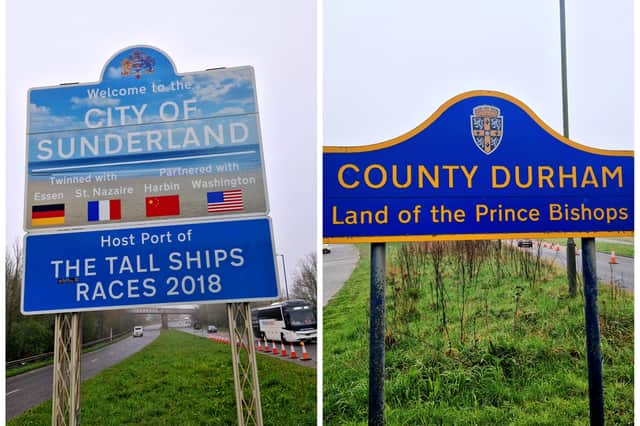Sunderland 'celebrates' 50 years of Tyne and Wear - a non-existent 'county' that no one ever wanted
and live on Freeview channel 276


April Fools’ Day marked a half-century of an institution, but the date passed with little fanfare.
April 1, 1974 saw the 1972 Local Government Act come into force. It brought about significant changes into how local government is run - and annoyance that is yet to be dispersed.
Advertisement
Hide AdAdvertisement
Hide AdSome of the act made for improvements and much of it is still relevant today. But to many people across this city the act is remembered for one solitary fact.
Sunderland was booted out of County Durham and forced into something called Tyne and Wear.
There was never going to be an easy and uncontroversial way to achieve the act's aims. But much of what was done was spectacularly misguided. Sunderland didn't want it. Nor did South Shields, Jarrow, Gateshead, Hebburn and others who had been in County Durham for a millennium or so.
North Shields, Wallsend, Whitley Bay and others were similarly shunted out of Northumberland.
Advertisement
Hide AdAdvertisement
Hide AdThere were celebrations to mark the new "counties" across the country.
By celebrations we mean "total outrage". But at least the creation of Tyne and Wear didn't quite ignite the fury felt in erstwhile Lancashire towns like Wigan, Bolton and Rochdale which were crowbarred into something called Greater Manchester.
Imagine. If Tyne and Wear had instead been named Greater Sunderland, we dare say there would have been a quibble or two.
Regardless of anyone's opinion, the concept of Tyne and Wear had some clout for 12 years. Tyne and Wear County Council was formed and first elected in 1973 and had significant budgetary power.
Advertisement
Hide AdAdvertisement
Hide AdBut it was Newcastle-centric. The council's HQ was there and its emblem was a T shape with no discernible W and featured the battlements of a castle; as in New-castle. A less than subtle clue.
Feelings were exacerbated when Sunderland had to wait 22 years for the Tyne and Wear Metro to be extended to (pockets of) Wearside, despite costs for the system being shared across the "county".
Between 1980 and 2002 the system was occasionally referred to as the Tyne and More Tyne Metro.
But the main source of annoyance provided by the Local Government Act was the perceived abandonment of history. For half-a-century now Sunderland has wanted to return to County Durham; although many still insist that it never actually left.
Advertisement
Hide AdAdvertisement
Hide AdOne thing is sure. If Tyne and Wear was ever even a county officially, even that flimsy claim expired in 1986 when the Tyne and Wear County Council was abolished to the chagrin of no one at all.
Since then Sunderland has not officially been in any county. Tyne and Wear simply does not exist. There is no need to include any county in your address, but if you do, County Durham can only be more accurate by simple virtue of it actually existing.
This has been true for 38 years; 50 years if you have a slightly different view.
What did Sunderland and the others lose in 1974? Heritage, history and identity is the short answer.
Advertisement
Hide AdAdvertisement
Hide AdOne small yet instructive example is the Miners' Memorial in Durham Cathedral, urging us to "Remember before God the Durham miners who have given their lives in the pits of this county and those who work in darkness and danger today."
The plaque was erected in 1947. Since 1974 the hundreds of miners who died in Monkwearmouth, Ryhope, Houghton, Washington, etc are no longer recognised by the plaque - arguably, but insultingly either way.
Being part of Durham again would restore the connection Sunderland had (has?) with the county's place in history, cathedral (easily the region's greatest and most important landmark), castles, folklore, a top class cricket club and ground, Cuthbert and the story of the DLI - regiment of many a fallen Sunderland soldier.
Sunderland could restore to County Durham centuries of highly important industrial heritage, miles of beautiful beaches, a second university, the Venerable Bede, a great (historically at least) football club, St Peter’s Church, the finest sports stadium in the North East and - coming soon - a world class film studio.
This all looks great in the brochures.
Advertisement
Hide AdAdvertisement
Hide AdSimilarly aggrieved areas have managed restoration. Humberside mercifully disintegrated in 1996 to re-join Yorkshire. The tiny county of Rutland broke away from Leicestershire in 1997. Good for them.
Sunderland doesn't even have anything to break away from. As said earlier, it isn't in any county.
Furthermore, the city would not be run from Durham County Hall as proved by Darlington, Hartlepool and Stockton; all in the ceremonial county, but self governed.


It is difficult to see what significant obstacles prevent Sunderland and the others from being absorbed back into the county they belong, other than apathy.
Advertisement
Hide AdAdvertisement
Hide AdUndoubtedly there will be those who say "Who cares?" to all of this, thereby confirming that they aren't worth listening to.
It wouldn't be "dwelling on the past". Quite the opposite actually. We have 50 years of this nonsense to put behind us and move forward.
Before publishing this article we deliberately waited until after the April 1, 2024 anniversary of the pointless, irritating and benefit-free decision to invent a "county". This was to see if any corks would be popped to mark the occasion.
Unsurprisingly, they weren't. Just like in 1974.
There is no significant reason not to reverse this horribly ill-considered decision to diddle Sunderland out of what is truly hers - being part of County Durham and forgetting that Tyne and Wear ever happened.
Comment Guidelines
National World encourages reader discussion on our stories. User feedback, insights and back-and-forth exchanges add a rich layer of context to reporting. Please review our Community Guidelines before commenting.